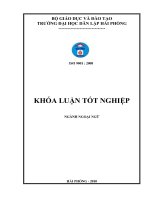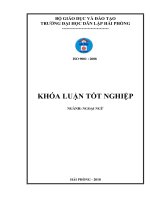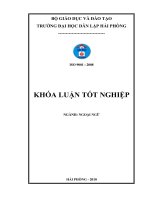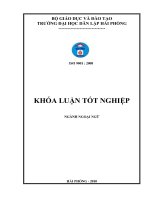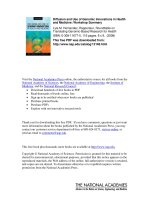A study on compound nouns in some famous literature works
Bạn đang xem bản rút gọn của tài liệu. Xem và tải ngay bản đầy đủ của tài liệu tại đây (403.55 KB, 62 trang )
1
Bộ giáo dục và đào tạo
tr-ờng đại học dân lập hải phòng
ISO 9001-2008
Khóa luận tốt nghiệp
ngành: ngoại ngữ
Hải phòng - 2009
2
HAI PHONG PRIVATE UNIVERSITY
DEPARTEMENT OF FOREIGN LANGUAGES
ISO 9001-2008
Graduation paper
A study on compound nouns in some famous
literature works
By:
Nguyễn Thị Huệ
Class: NA904
Supervisor:
Nguyễn Thị Lệ Hằng, M.A
HẢI PHÒNG 2009
3
BỘ GIÁO DỤC VÀ ĐÀO TẠO
TRƯỜNG ĐẠI HỌC DÂN LẬP HẢI PHÒNG
NHIỆM VỤ ĐỀ TÀI TỐT NGHIỆP
Sinh viên: …………………………………………… Mã sinh viên: ………….
Lớp: ………………………………………………… Ngành: ………………
Tên đề tài: ………………………………………………………………………
………………………………………………………………………
………………………………………………………………………
4
NHIỆM VỤ ĐỀ TÀI
1. Nội dung và các yêu cầu cần giải quyết trong nhiệm vụ đề tài tốt nghiệp
(Về lý luận, thực tiễn, các số liệu cần tính toán và các bản vẽ)
2. Các số liệu cần thiết kế, tính toán.
3. Địa điểm thực tập tốt nghiệp.
5
CÁN BỘ HƯỚNG DẪN ĐỀ TÀI TỐT NGHIỆP
Người hướng dẫn thứ nhất:
Họ và tên:
Học hàm, đơn vị công tác:
Cơ quan công tác:
Nội dung hướng dẫn:
Người hướng dẫn thứ hai:
Họ và tên:
Học hàm, đơn vị công tác:
Cơ quan công tác:
Nội dung hướng dẫn:
Đề tài tốt nghiệp được giao ngày tháng năm 2009.
Yêu cầu phải hoàn thành xong trước ngày tháng năm 2009.
Đã nhận nhiệm vụ Đ. T. T. N Đã giao nhiệm vụ Đ. T. T. N
Sinh viên: Cán bộ hướng dẫn Đ. T. T. N
Hải Phòng, ngày tháng năm 2009
HIỆU TRƯỞNG
GS.TS.NSUT.Tran Huu Nghi
6
PHẦN NHẬN XÉT TÓM TẮT CỦA CÁN BỘ HƯỚNG DẪN
1. Tinh thần và thái độ của sinh viên trong quá trình làm đề tài tốt nghiệp.
2. Đánh giá chất lượng của Đ. T. T. N (So với nội dung yêu cầu đã đề ra
trong nhiệm vụ Đ. T. T. N trên các mặt lý luận, thực tiễn, tính toán giá trị
sử dụng, chất lượng các bản vẽ, …).
3. Cho điểm của cán bộ hướng dẫn :
(Điểm ghi bằng số và chữ)
Hải Phòng, ngày tháng năm 2009
Cán bộ hướng dẫn chính
(Họ tên và chữ ký)
7
NHẬN XÉT VÀ ĐÁNH GIÁ CỦA CÁN BỘ CHẤM PHẢN BIỆN
ĐỀ TÀI TỐT NGHIỆP
1. Đánh giá chất lượng đề tài tốt nghiệp về các mặt thu thập và phân tích số
liệu ban đầu, cơ sở lý luận chọn phương án tối ưu, cách tính toán chất lượng
thuyết minh và bản vẽ, giá trị lý luận và thực tiễn của đề tài.
2. Cho điểm của cán bộ phản biện:
(Điểm ghi bằng số và chữ)
Hải Phòng, ngày……tháng……năm 2009
Người chấm phản biện
(Họ tên và chữ ký)
8
TABLE OF CONTENTS
ACKNOWLEDGEMENTS
Part one: INTRODUCTION
1. Rationale of the study…………………………………………………………1
2. Aims of the study…………………………………………………………… 2
3. Methods of the study………………………………………………………….2
4. Scope of the study………………………………………………………… 3
5. Design of the study………………………………………………………… 3
Part two: DEVELOPMENT
CHAPTER ONE: THEORETICAL BACKGROUND
1. An overview of compounding in English 4
1.1 Definition 4
1.2 Characteristic feartures 4
1.2.1 The morphemes of a compound word 4
1.2.2 The components of a compound word 4
1.2.3 The function of a compound word 5
1.2.4 Common English compounds 5
1.3 Criteria of compound words 6
1.3.1 Phonological criterion 6
1.3.2 Inseparability criterion 6
1.3.3 Semantic criterion 7
1.3.4 Graphic criterion 7
1.4 Classifications of compound words 10
1.4.1 Classification according to the meaning 10
1.4.2 Classification according to the componental relationship 12
1.4.3 Classification according to the part of speech 14
1.4.4 Classification according to the compositional type 17
1.4.5 Miscellanea of compounds 18
9
CHAPTER TWO: AN INVESTIGATION INTO COMPOUND NOUNS IN
SOME FAMOUS LITERATURE WORKS
I.An overview of compound nouns in literature 21
1. Types of compound nouns 21
2. Analyzability 22
II. The frequency of compound nouns 23
1. Non-idiomatic and Idiomatic compound nouns 23
1.1 Non-idiomatic compound nouns 23
1.2 Idiomatic compound nouns 26
2. Coordinative and Subordinative compound nouns 26
2.1 Coordinative compound nouns 26
2.2 Subordinative compound nouns 27
3. Word-class combination compound nouns 28
3.1 Noun-Noun compound nouns 28
3.2 Noun-Verb compound nouns 29
3.3 Verb-Noun compound nouns 30
3.4 Adjective-Noun compound nouns 32
3.5 Adjective-Verb compound nouns 33
3.6 Verb-Adverb compound nouns 34
4. Compositional types of compound nouns 34
4.1 Compound nouns formed by juxtaposition 34
4.2 Compound nouns formed by morphorlogical means 36
4.3 Compound nouns formed by syntactic means 37
4.4 Compound nouns formed both by morphological and
syntactical means 37
5. Miscellanea of compound nouns 38
5.1 Derivational compound nouns 38
5.2 Reduplicative compound nouns 38
5.3 Faded compound nouns 38
5.4 Dead compound nouns 39
5.5 Compound nouns formed by prepositional adverbs 40
10
Chapter three: Implication of the study
1. The use of compound nouns and its effective in literature works
2. Some considerations into the translation of compound nouns in literary works
from English into Vietnamese 41
2.1 Translation of idiomatic compound nouns 41
2.2 The differences between the translation and the original 41
3. Common problems of compound nouns in some famous literature works 42
3.1 Some difficulties in recognizing and analysing compound nouns 42
3.1.1 In sufficient consistency of semantic criterion 42
3.1.2 In sufficient consistency of graphic criterion 42
3.2 Difficulties in distinguishing compound nouns and other word classes 43
3.2.1 Distinction between compound nouns and free word groups 43
3.2.1.1 Basing on phonological criterion 43
3.2.1.2 Basing on graphic criterion 44
3.2.2 Distinction between compound nouns and derived words 45
3.3 Others 45
3.3.1 Some mistakes and difficulties in forming plurals and possessives of
compound nouns 45
3.3.1.1 Forming plurals 45
3.3.1.2 Forming possessives 46
3.3.2 Misunderstanding of the meanings of compound nouns 47
4. Some suggestions to problems 47
4.1 Distinguish compound nouns with nouns modified with an adjective 48
4.2 Identify compound nouns basing on graphic criterion 48
4.3 Other suggestions 48
Part three: CONCLUSION
1. Summary of the study 49
2. Suggestion for further study 50
REFERENCES 51
11
ACKNOWLEDGEMENTS
From bottom of my heart, I would like to show my deepest gratitude to
many people helping and encouraging me enthusiastically in preparing and
completing the graduation paper.
First of all, I would like to express my heart felt thanks to Mrs. Nguyen
Thi Le Hang, (MA), my supervisor, who has given me many valuable guidance,
correction and advices for my research
Also, I would like to thank Ms. Tran Thi Ngoc Lien – Dean of Foreign
Language Department for her help during my completion of the paper.
Next, I am also grateful to all teachers at Hai Phong Private University
whose support and advices has improved my study.
Last but not least, I owe sincere thanks to all members of my family and
friends for whatever they supported and encouraged me both mentally and
physically in the progress of writing this graduation paper.
I know my graduation paper still keeping mistakes for my shortcomings. I
would like to receive your comments, suggestions and corrections for the perfect
of my own graduation paper.
12
Part one:
INTRODUCTION
1. Rationale of the study
English is considered as the most widely used language with more than
60% of the world population speaking this. It is also a second language that was
taught commonly around the world. I, an English major, find it not easy but very
interesting to study further this global language.
Students in the process of acquiring this language are always aware that it
greatly contributes to bring different nations with different languages and culture
close together. And, I myself realize that literature is not only of vital spiritual
value of people but also serves as one of the best ways for better understanding
between nations, especially in the globalization process.
However, the learners as well as the readers sometimes feel much confused
about interpreting literary works thoroughly. The difficulties come from
different factors including cultural, literary nuances, language in use, however,
one of the parts that attract much of my attention is working on the funtions
language in use in literary works especially the working mechanism of
compound nouns in famous literary works which during the preliminary reseach,
I myself found prominent. This causes readers certain difficulties in
understanding and perceiving literature works. Therefore, it drives me to
conduct a more thorough study on the problem. I hope that from the comparative
study between English and Vietnamese compound nouns in famous literary
works, we can find similarities and also differences.
Therefore, the following study shows English learners not only the
charecteristics but also the usage of compound nouns in literature in order that
this research may become effective.
13
2. Aims of the study
My research is aimed at:
- identifying the structure of compound nouns in some famous Eglish
and Vietnamese literary works
- finding out the frequency of compound nouns in English and
Vietnamese literature works in order to hypothesize the presence of
these nouns in literature
- providing learners some charecteristics, classifications of compound
nouns in order to facilitate the effective use of these nouns
- pointing out some differences between compound nouns and giving
many useful examples to make my research become reliable.
- figuring out some difficulties and suggesting solutions to overcome.
3. Methods of the study
At the first time, I began to study English, I myself find that English is the
most commom used laguage in society. I have been trying my best to study for
further fields of English. Thanks to the knowledge and experiences which I gain
from my teachers as well as reference books I had read in the process of learning
English and completed my graduation paper. These are some helpful sourses:
First, data collected from literature books, newspapers both in English and
Vietnamese as well as internet to have useful information about literature works.
Survey with questionnaire is also made to find out the feedback from
students in their literary lessons in perceiving some difficulties.
The data is then analyzed to find out the frequency of compound nouns in
English literary works so that the reseacher can figure out the reason for their
presence.
Furthermore, a comparative study is also made to identify the operating
mechanism of compound nouns in English and Vietnamese literary works in
order that effective measures can be put forth to deal with the problems possibly
arisen in using compound nouns in English and Vietnamese literary works.
14
4. Scope of the study
Because of the knowledge, experiences, and time frame. I could not take a
study on all related to compound nouns.
In addition, the matter word-formation is rather complex with different types
including compound nouns.
Therefore, my reserch paper only focus on compound nouns in English
literature works and Vietnamese equivalents. Hopefully, my research will partly
help students have an general overview on compound nouns and their effective
use in such kind of works.
5. Design of the study
The study composes three parts in which the second part is the most
important one.
The first, INTRODUCTION, presents about rationale, aims, methods,
scope and design of the study.
The second, namely DEVELOPMENT, consists three following chapters:
Chapter one provides an overview of some theoretical concepts
such as definition, criteria, and classification of compounds
Chapter two presents an investigation into compound nouns in
literature works.
Chapter three highlights some possible problems faced by
Vietnamese readers and learners of English literary works regarding the
interpretation of compound nouns.
The third, CONCLUSION, summaries the study mentioned above and
give some suggesions for futher study.
15
Part two:
DEVELOPMENT
Chapter one:
Theoretical background
1. An Overview of Compounding in English
1.1 Definition
Compounding (or word – composition) is the process of building a new
word by joining two or more words together.
Eg: lady-killer schoolboy
warm-hearted ear shell
1.2 Characteristic features
1.2.1 Structurally, a compound word consists of at least 2 root morphemes:
E.g: front-door sign-post
coach-man gravel-walk
1.2.2 The components of a compound word
The components of a compound word may be either simple or derived words
or even other compound words.
Dust-collector dry land
Easy-going earth-house
For exemple:
Blackboard > the components of the compounds ―blackboard‖ consist of
2 simple words ―black‖ and ―board‖.
Lady-killer > the compound noun ―lady-killer‖ consist of one simple word
―lady‖ and one derived word ―killer‖.
Landscape-painter > the components of this compounds are:
landscape(compound word)
painter( derived word)
16
1.2.3 The function of a compound word
A compound word can function in a sentence as separate lexical unit due to
their integrity, semantic unity and so on.
1.2.4 Common English compounds
In general, English compounds have two stems that are:
+determinatum (basic part): express a general meaning
+determinant (determining part): the determining one
For example: end-product ear-finger
diving-dress dream-land
In the example above, ―product, dress, finger, land‖ express a general meaning
thus being the basic part in the compound (determinatum)
The first part ―end, diving, ear, dream‖ being the determining one (determinant)
Normallly, the determinant is the first element in a compound but sometimes it
is the second one.
E.g: passer-by
hanger-on
passer and hanger is the determinatum (the basic part in the compounds), by and
on is the determinant (the determining one). Grammartically, determinatum
undergoes inflection
E.g: door-step > door-steps
(to) handwash > handwashes, handwashed, handwashing
fly-driver > fly-drivers
Concerning compound words there are still many problems that cause
controvercy, how to distinguish between compounds and free word groups, for
example.
17
1.3. Criteria of compound nouns
1.3.1Phonological criterion
- In English there is a great tendency to give compounds a heavy stress on the
first element. Most compound nouns are stress on this pattern and the stress falls
on the determinant.
E.g: ‗sunrise ‗woodwork ‗nightfall
‗teapot ‗drawingroom ‗gateman
In the example above, the stress fall on the first element (determinant) ―sun,
tea, wood, drawing, night, gate‖.
- In free word groups, stress falls on every word
E.g: ‗dancing ‗girl
‗hot ‗head
- There are also many compound words which have double stress
(even stress) :
E.g: ‗bread and ‗butter ‗carrier-‗pigeon
‗sleeping ‗bag ‗look-‗out (tram gac)
The compound nouns bread and butter stress both bread and butter
And, in the compound gray-green stress put in adjective gray and green
1.3.2.Inseparability criterion
The components of a compound word are indivisible (It is impossible to
insert any other word between elements of a compound word)
E.g: black board (# black and white board)
redtape (# red and white tape)
These elements lose their grammartical independence and endings are added
to the whole word.
E.g: boy-friends doorsteps
forget-me-nots armchairs
Sometime components of a compound can be separated like the case:
E.g: cigar and cigarette smokers
women and man doctor
18
1.3.3 Semantic criterion
Arcording to this criterion, Hoang Tat Truong state his views that ―A
compound word only express a single idea despite the fact that it consists of two
or more words.
The meaning of the whole compound word is not the sum of the meanings of
its components
For example:
Greenfood = vegetable
# green food = food of green color
Similarity, White hall = English government
# the hall painted white
And black gold = petroleum
# gold with black color
1.3.4 Graphic criterion (spelling criterion)
This criterion means that we can rely on the spelling of a word group to
discriminate between free word groups and compounds. In terms of graphic
criterion, compound nouns are classified into 3 kinds:
1.3.4.1 The “solid” or “closed”form (as one word)
The ―solid‖ or ―closed‖ forms in which two usually moderately short words
appear together as one. Solid compounds most likely consists of short units that
often have been established in the language for a long time.
For example: housewife, lawsuit, wallpaper
The ―close‖form, in which the words are melded together:
Example: fortlight handmaid childlike
redhead
secondhand softball crosstown firefly
Sunstone stoneman makeup notebook
19
1.3.4.2. The hyphenated form (two words joint with a hyphen)
The hyphenated form means that two or more words are connected by a
hyphen. The hyphen is often as a visual link, so as to make the distinction that is
made in speech by stressing the first word of the compound.
E.g: dining – table dog - grass
breech – sight (muc tieu) front - bench
Compounds that contain affixes as well as adjective-adjective, verb-verb are
often hyphenated.
E.g: sign – writer blue-green
double – acting freeze-dry
Compound that contain articles, prepositions or conjunctions are often
hyphenated such as:
ren-a-cop mother-of-pearl
life-and-death sleight-of-hand
To be more specific, these are a few guidelines:
Hyphenate two nouns in apposition that indicate different but equally
important funtions. The compounds constitutes a new, single idea.
E.g: tractor - trailer
city– state
Hyphenate normally written as two words when they are preceded by a
modifier which might create an ambiguity.
E.g: public letter – writers # public writer
The expression ―public letter – writers‖ clarify that the letter writers write
for the public, rather than that they write letters that are of a public nature.
Hyphenate compound units of measurement created by combining single
units that stand in mathematical relationship to each other.
E.g: person – day
Kilowatt – hour
20
Noun + gerund compounds are not hyphenated. They may appear as separate
or single words
E.g: shipbuiding
decision making
In compound adjective, hyphenated when attibutive but not hyphenated
when predicative:
E.g: They were well-balanced soldiers
You have to be well balanced to cope with the stress of your
job
A hyphen is generally used to combine different parts of speech to form a
compound
E.g set - minded man -of -war
good -for -nothing woman- of- the town
A hyphen is also used to advoid the ugliness in word-spelling
E.g: night-time
When modifying a person with his or her age, the compounded phrase is
hyphenated:
For example: my six-year-old son.
However, when the age comes after the person, we don't use a hyphen.
My son is six years old. He is, however, a six-year-old.
1.3.4.3 The open or spaced form (as two separate words)
The open or spaced form consisting of newer combinations of usually longer
words.
E.g: drug store tea rose (cay thanh tra)
dry land road safety
Notes:
This criterion often causes argument as well. In English spelling, there is lack of
consistency. Different people, different dictionaries have different spellings.
21
We may come across two ways of spellling ―bread and butter‖:
She earns her bread and butter by teaching evening classes
She earns her bread - and -butter by teaching evening classes
Sometimes a word may be spelled in many ways:
E.g: night club = nightclub
city central = citycentral
E.g:
matchbox match - box match box
airline air - line air line
paperclip paper- clip paper clip
It goes without saying that we can not base ourselves on only one criterion. It
is usually necessary to refer to at least two or sometimes all these criteria to
decide whether such and such word groups are compounds.
1.4 Classification of compound words
1.4.1 Classification according to the meaning
This classification can be call ―semantic classification‖. According to the
meaning, compounds can be non-idiomatic (motivated) or idiomatic (non-
motivated).
1.4.1.1Non-idiomatic compounds (motivated)
The meaning of the whole word is easily deduced from the meanings of the
components.
For example:
goal-keeper = player who stand in the goal
color-blind = person who can not see any thing
salesgirl = the girl whose occupation is to sell goods or merchandise
love story = the story about love
22
In some cases, they are partially non-idiomatic since the motivation is partial:
For example:
newspaper = A sheet of paper printed and distributed
mother-in-law = mother of one‘wife or husband
However, in some cases, the semantic head is not explicitly expressed.
E.g: a redhead = a person with red hair, not a kind of head
1.4.1.2 Idiomatic compounds
Idiomatic compounds are those whose meanings can not be deduced because
there is no relationship between the meanings of the components.
Lack of motivation in these words is related to figurative usage of their
components:
For example:
monkey-bussiness = buffoonery (there is no relationship between the meanings
of ―monkey‖ and ―business‖)
teach-in = seminar, workshop ( no relationship between the meaning of ―teach‖
and ―in‖)
lady killer = A gallant who captivates the hearts of women
He makes acquantances with many people including girls who love him very
much. It is true that he is a lady killer.
egghead = very intellectual person
blacksheep = person who brings shame to his family as in below example:
Jame‘family is very famous for studiuos tradition. His siblings all are studying
in universities and receives schorlarships every year. But he has failed his
extrance exam to become a student. He is certainly the blacksheep of his family.
Because idiomatic compounds are related to figurative usage of their
components, It is very difficult for the learners to understand the meaning of
these compounds that makes learners misunderstand and confuse when speaking
with foreigners as in following example:
John: Nam, there is a bluebottle on the table.
23
Nam: Yes, I know. Why?
John: Bluebottles are dirty, you know?
Nam: Nonsence, I‘ve washed it carefully.
In the dialogue below, the Vietnamese people make a mistake because a bluebottle
here is a fly - one kind of insect which is very dirty and causes many diseases.
In some cases, It also creates a lot of jokes and funny as in a story below:
First women: That doctor is quite a lady-killer.
Second women (not very attentive): My God! I‘d better go and see another.
The second women makes a mistake when thinking that doctor is a person
killing many people, but in fact, he is a gallent who captivates the hearts of
women.
1.4.2 Classification according to componental relationship
According to the connection between the components we have:
1.4.2.1Coordinative compounds
Coordinative compounds are those who components are both structurally and
semantically independent.
For example:
actor-manager = actor + manager ( actor and manager are both structurally
and semantically independent)
Also, Anglo – Saxon = Anglo + Saxon ( Anglo and Saxon are both structurally
and semantically independent)
To be more clearly, see some coodinative commpounds:
willy-nilly fifty-fifty
hoity-toity goody-goody
These coordinative components are not numerous but we can coin many for the
sake of economy :
Parent-teacher ( parent-teacher association)
Coordinative compounds combine elements with a similar meaning, and the
meaning of compounds may be generalization instead of a specialization.
24
E.g: fighter-bomber
Bosnia-Herzegovina, for example, is the combined area of Bosnia and Herzegovina
but a Fighter-bomber here is an aircraft that is both a fighter and a bomber
1.4.2.2 Subordinative compounds
Subordinative compound are those that are characterized by the domination
of one component over the other.
The second component is the structural centre, the determminatum (the basic
part).And the first component is the determinant (the determining one).
For example:
policeman # stoneman
structural centre
(police and stone are determinant, help policeman distinguish from
stoneman)
Similarity, we can list some compound words
bookhouse = the publisher
boat house = a house for sheltering boats
big house = a prison
bake house = a house for baking
bath house = a bathroom
In the example above, house is the structural centre (the determinant - the basic
part). We distinguish each from the others according to the determinant book,
boat, big, bake, bat.
In terms of farmilies of compound, there are many sets of compounds base on
the same word. In such sets, the second element is the same, but its relationship
with each member of its set likely tobe different.
For example:
schoolboy = a boy attend a school
lowboy is not a boy who is short, is a chest of drawers not more than four feet
high
25
Similarly, we have:
air bed = a bed is full of air
flower bed = is not a bed with flowers, is a place in which flowers are growing
In determinative compounds, the relationship is not attributive. These
relationships are expressed by prepositions in English, be expressed by
grammartical case in other languages
For example:
bookstore = is a store for book
lovestory = is a story about love
breath test = is a test of breathy
This type of compounds is called endocentric compounds because the semantic
head is contained within the compound itself
bluewhale is a whale with blue color
office manager is the manager of an office
However, there is often vague borderline between coordinative and
subordinative compounds.
1.4.3 Classification according to part of speech
According to the part of speech, compounds are classified as following:
Nouns
Adjectives
Compounds Verbs
Adverbs
Prepositions
Conjunction
1.4.3.1 Compound nouns
Compound nouns are the compounds that function as nouns
E.g: doorkey
girl hunter



